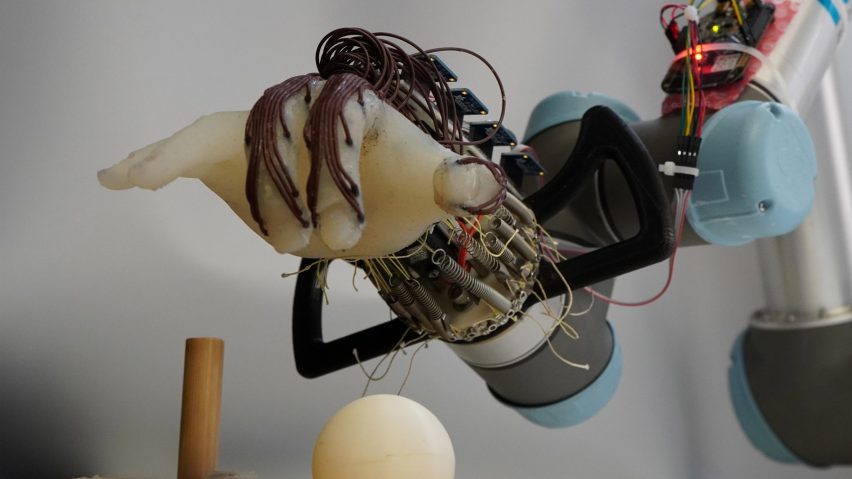
"As machine learning progresses tactile design becomes ever more important"
Design involving artificial intelligence will always require a human touch, write YuJune Park and Caspar Lam as part of our AItopia series.
There's no escaping the rapid and impressive advancements in artificial intelligence (AI), which have naturally led to equal parts excitement and panic.
Meanwhile, last month, scientists at the University of Cambridge presented a 3D-printed robot hand capable of 'touch' (pictured). The robotic hand can grasp objects using the feeling in its 'skin', yet can't move its fingers independently of each other. That means no pointing, counting, or chef's kiss: the robotic hand symbolises how even advanced technology cannot hope to speak to the totality of human experience.
Even advanced technology cannot hope to speak to the totality of human experience
We've seen the progressive capabilities of AI in pattern recognition for text and images, enabling "smart" editing (automatically "improving" or modifying an image or written passage) and the ability to generate both text and image through prompts. Moreover, AI is now capable of "seeing" and "coding", which gives designers the capability to move from ideation to prototyping almost instantaneously.
In many ways, the tasks related to execution are being outsourced to AI, and it is here that a designer's ability to discern, to critique, and to contextualise becomes more important.
Indeed, there are so many aspects of human experience – especially in the context of design and creativity – that will never be replicated by any technology.
As technology and machine learning progress, a tactile, human approach to design becomes ever more important. Where many have seen AI developments as encroaching uncomfortably on designers' work, on a more positive note it's creating new opportunities to explore the relationship between the digital and the physical.
As AI becomes more advanced, digital experiences could be more easily generated because of their fundamental structure being built from code. It will provide the ability to iterate and bring to fruition ideas that may previously have been laborious to prototype, such as complex data visualisations. It can take away the time-consuming legwork for designers.
But at the same time, for this stuff to have value in the physical world, designers need to develop a more discerning eye to understand and refine AI's output by providing critique, contextualisation, and ultimately providing a human perspective.
We have to return to the essence of the role of the designer
Design can act as a translator between our experiences of the physical and digital, reconfiguring the digital experience into one that is more familiar to us. Think skeuomorphism – digital design in which items mimic their real-world counterparts, such as early iPhone calculator designs.
On the other side of the coin, design can hide and make the digital experience invisible so that we do not see what is happening underneath in order to make the experience more comfortable and usable. Think loading indicators that hide the realities of processing computation and code.
Since many of the laborious and repetitive tasks by designers can easily be replaced by AI, we have to return to the essence of the role of the designer, which is about the more philosophical and existential role of human beings and the things they create. Human beings are often defined by their ability to utilise tools and the open question is: are we able to utilise and harness this new tool, AI?
It becomes necessary to consider the value of the human person and their ability to see and imagine which is shaped by the experiences of the five senses. Ultimately, it is through these five senses that we encounter the world, whether man or machine-made.
It would be useful to revisit the discussions surrounding the 1860s Arts and Crafts movement, which emerged in the wake of the industrial revolution. Its main tenets were around craftsmanship, which stresses the inherent beauty of the material, drawing inspiration from nature and the value of simplicity, utility and beauty. Ultimately, it interrogated what we collectively value as a culture, a society, and as makers in light of these ideas around the more sensorial aspects of design.
Whether a practising professional or a student, designers should make time to enhance their creativity away from a computer screen and explore more tactile approaches – exploring a museum or gallery; browsing the stacks in a library; trying out physical printmaking techniques.
Now more than ever, it's vital that designers trust both their eyes and their hands
In being mindful of the ways in which we observe and the emotional resonance of the handmade, we see more clearly how human designers have power beyond the capacity of technology. While AI might be able to one day mimic the way the eye moves across a painting, arguably it will never be able to articulate or replicate how doing so elicits deep, powerful feelings in people.
In general, designers need to be more observant. Tuning into the aforementioned five senses gives designers the ability to compare and to develop preferences – something that an AI out of a box does not have and could never have, because AI can ultimately be re-trained and re-programmed. As human beings, we like what we like and dislike what we dislike. Sometimes, that subjectivity is seen as a flaw, but paradoxically it's what allows us to create variety and new experiences.
Each designer responds to the material world differently and weaves their own mythologies into their creative works. The interaction between intuition and form and the translation between vision and media are the genesis of creativity, and it's only by learning through making that we serendipitously discover the real reasons why we are attracted to certain forms and the joy that results from their discovery.
Designers should think about how the design we cannot see, but still experience, is often the most inspirational. They should consider the ways in which you can bring tactile qualities to design with the use of multimedia, interactive techniques including sound, light, haptics, user interface, user experience, and more.
Now more than ever, it's vital that designers trust both their eyes and their hands, as well as the feedback of digital technologies. It's the only way that they can truly grasp how the physical translates to digital – and vice versa – and how great design elicits powerful emotions.
YuJune Park and Caspar Lam are co-founders of New York digital design consultancy Synoptic Office and associate professors of communication design at Parsons School of Design.
The photography is courtesy of the University of Cambridge.
Dezeen In Depth
If you enjoy reading Dezeen's interviews, opinions and features, subscribe to Dezeen In Depth. Sent on the last Friday of each month, this newsletter provides a single place to read about the design and architecture stories behind the headlines.

AItopia
This article is part of Dezeen's AItopia series, which explores the impact of artificial intelligence (AI) on design, architecture and humanity, both now and in the future.